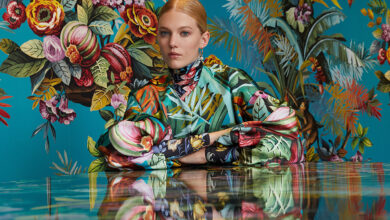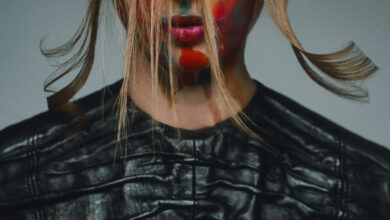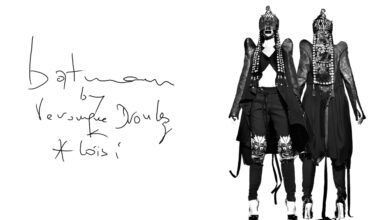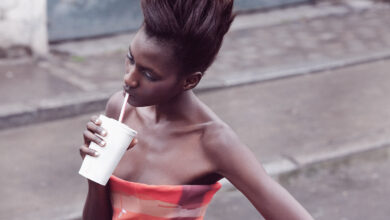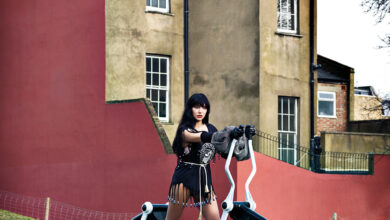DesignFashionZoot agenda
[AY]A STUDIO'S LANDSCAPISMS AND DIGISCAPES
The Paris-based [Ay]A Studio has just launched a collection blurring the boundaries between art, fashion and architecture.
Text by Anna Battista

As a young architecture student, Jorge Ayala always displayed a strong passion for fashion. After he graduated and went on to become the Director of the AA Visiting School in Paris and founder of the [Ay]A Studio, his passion for this discipline prompted him to experiment further. In the last few months Ayala’s interest in fashion and in clothing the body with structures borrowed from architecture became one of his main fields of research and he started developing a proper collection with his team.
Based on the actualisation of digital scapes and entitled “Landscapism”, Ayala’s collection is a vision of the future in which the expressive tools of the traditional part of the designer’s trade co-exist with a preoccupation for solving spatial and structural problems more commonly expressed in architecture. Garments contain and define the space and are conceived and assembled as three-dimensional entities.
The launch of the collection concides with the beginning of a new course at Paris’ Architectural Association School that, entitled “Building Fashion”, explores the new possibilities offered by fashion and architecture through interdisciplinary laboratories.

Zoot Magazine: In a world with so many fashion designers, why would an architect decide to launch a fashion collection?
Jorge Ayala: We see the presence of so many fashion designers in the market as very competitive, but also as something very positive. Fashion is a unique creative platform that must go and is going through radical mutations. With this collection our main goal is fostering a sort of new culture, raising awareness within the fashion industry that we must try and avoid processes of mere aestheticisation while preventing at the same time the existing risk of anaesthetisation of our society.
Z: Architecturally speaking, what inspired the forms and shapes of your designs?
JA: Fashion constitutes mainly a form of ‘dreamworld’ rooted by precedents such as journeys – think about Jean Paul Gaultier’s A/W 2007-08 collection ‘Princes and Maharajas’ – or art mimicry, if you go back with your mind to Yves Saint Laurent’s S/S 1998 collection ‘Cubiste’. A group of architects also operates in the same manner: for our first collection we’ve been more influenced by a notion of a virtual world driven by a digital-based research. We tried to materialise such virtual terrains and pull them up onto the real world, onto physical instances. We obviously also looked at landscape shapes, artificial systems like machines or cyborg prosthesis for clothing devices.
Z: What kind of architectural processes did you use while working on the collection and do you think that specific materials employed in architecture can inspire also fashion designers?
JA: During the conception of our garments we went through many tests, both digital and physical. The digital tests mainly helped our form-finding processes while the physical tests at the beginning were strongly related with structure rather than form. We then tried to merge both and foster the hyper-integration of the formal resolution with its structure and function. Our designs are therefore the result of long processes of analysis, followed by implementing novel techniques of assembling and building garments. We are currently also creating jewellery pieces and accessories that go beyond the mere ornamental and use them as extensions of the body.
Z: How easy it is for your team working on a fashion collection?
JA: There are a series of contemporary conditions that make today’s society – visually and culturally – related to the world of fashion. As architects we were tempted to develop our designs onto a broader scale, beyond and above the architectural resolution. For the first collection the team started working on very basic geometries, combining them in a very systematic way, that is 3 circles generating a triangle, then 4 circles generating a square, then 5 circles generating an hexagon, and so on. The garments therefore acquired a degree of spatial complexity. We were also prompted by a will to criticise the capitalism undermining our society.
Z: In the history of fashion there are quite a few architects who turned into fashion designers, but not many fashion designers who turned into architects, according to you why is that so?
JA: Traditional educational programs – in fashion or architecture – don’t necessarily encourage such exchanges. I still remember that, when I was studying architecture in London and I showed my interest in fashion, some professors thought that fashion was something superficial and hollow.
Z: Would you encourage fashion design students to take the architecture path?
JA: I would actually encourage top schools to start thinking about a diploma that merges both the disciplines in one hybrid full degree. The level of complexity in both disciplines is quite similar. Academics such as myself must be prepared for this important shift.
Z: You’re preparing to launch a new course that merges fashion and architecture at AA Paris, what will it be about?
JA: Compared to our previous semester when we approached different fields of experimentation from retail store to catwalks prototypes, the progressive agenda for this semester is to look at clothing resolution. Capitalism itself promotes a sense of consumerism and uniform thinking when it comes to architecture and fashion. We’ve seen this topic as the starting point for our critical brief for this Autumn 2011, called “Self-Assembled Prêt-à-Porter”.
Z: Will the course also touch upon new materials/advanced techniques?
JA: Absolutely, this season we will form-find with fibreglass, resin and plaster in powder and latex sheets. We will try and adapt our design protocols and logics in such a way as to reflect our current technological transformations and digital and physical discoveries.
Z: If you could collaborate with a fashion designer who would you choose?
JA: I would love to collaborate with Rem D. Koolhaas since United Nude’s designs are very interesting.
Z: Where will you present your collection in Paris?
JA: Visitors can see our works in our studio in Rue Saint Dominique in Paris. Digital visitors can instead follow our work on our website, www.ayarchitecture.com, and blog, www.jorge-ayala.com.
“Building Fashion” is at the Musée des Arts Décoratifs, Rue de Rivoli, Paris, from 31st October to 10th November.






